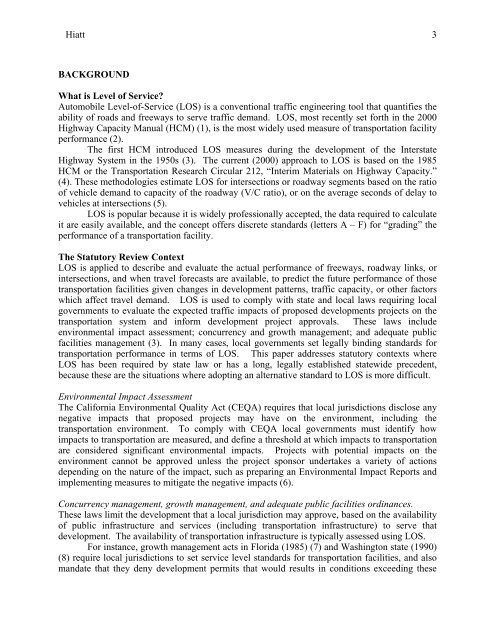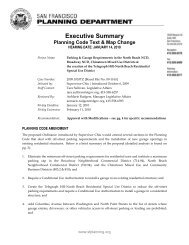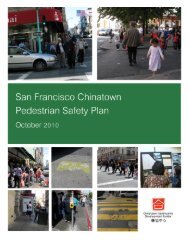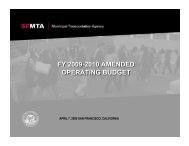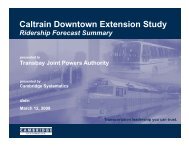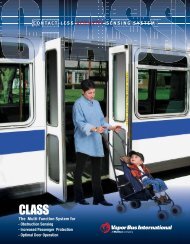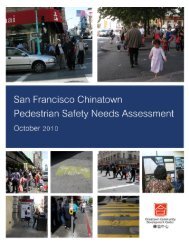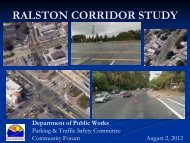Alternatives To Auto LOS For Impact Analysis 111505
Alternatives To Auto LOS For Impact Analysis 111505
Alternatives To Auto LOS For Impact Analysis 111505
Create successful ePaper yourself
Turn your PDF publications into a flip-book with our unique Google optimized e-Paper software.
Hiatt 3<br />
BACKGROUND<br />
What is Level of Service?<br />
<strong>Auto</strong>mobile Level-of-Service (<strong>LOS</strong>) is a conventional traffic engineering tool that quantifies the<br />
ability of roads and freeways to serve traffic demand. <strong>LOS</strong>, most recently set forth in the 2000<br />
Highway Capacity Manual (HCM) (1), is the most widely used measure of transportation facility<br />
performance (2).<br />
The first HCM introduced <strong>LOS</strong> measures during the development of the Interstate<br />
Highway System in the 1950s (3). The current (2000) approach to <strong>LOS</strong> is based on the 1985<br />
HCM or the Transportation Research Circular 212, “Interim Materials on Highway Capacity.”<br />
(4). These methodologies estimate <strong>LOS</strong> for intersections or roadway segments based on the ratio<br />
of vehicle demand to capacity of the roadway (V/C ratio), or on the average seconds of delay to<br />
vehicles at intersections (5).<br />
<strong>LOS</strong> is popular because it is widely professionally accepted, the data required to calculate<br />
it are easily available, and the concept offers discrete standards (letters A – F) for “grading” the<br />
performance of a transportation facility.<br />
The Statutory Review Context<br />
<strong>LOS</strong> is applied to describe and evaluate the actual performance of freeways, roadway links, or<br />
intersections, and when travel forecasts are available, to predict the future performance of those<br />
transportation facilities given changes in development patterns, traffic capacity, or other factors<br />
which affect travel demand. <strong>LOS</strong> is used to comply with state and local laws requiring local<br />
governments to evaluate the expected traffic impacts of proposed developments projects on the<br />
transportation system and inform development project approvals. These laws include<br />
environmental impact assessment; concurrency and growth management; and adequate public<br />
facilities management (3). In many cases, local governments set legally binding standards for<br />
transportation performance in terms of <strong>LOS</strong>. This paper addresses statutory contexts where<br />
<strong>LOS</strong> has been required by state law or has a long, legally established statewide precedent,<br />
because these are the situations where adopting an alternative standard to <strong>LOS</strong> is more difficult.<br />
Environmental <strong>Impact</strong> Assessment<br />
The California Environmental Quality Act (CEQA) requires that local jurisdictions disclose any<br />
negative impacts that proposed projects may have on the environment, including the<br />
transportation environment. <strong>To</strong> comply with CEQA local governments must identify how<br />
impacts to transportation are measured, and define a threshold at which impacts to transportation<br />
are considered significant environmental impacts. Projects with potential impacts on the<br />
environment cannot be approved unless the project sponsor undertakes a variety of actions<br />
depending on the nature of the impact, such as preparing an Environmental <strong>Impact</strong> Reports and<br />
implementing measures to mitigate the negative impacts (6).<br />
Concurrency management, growth management, and adequate public facilities ordinances.<br />
These laws limit the development that a local jurisdiction may approve, based on the availability<br />
of public infrastructure and services (including transportation infrastructure) to serve that<br />
development. The availability of transportation infrastructure is typically assessed using <strong>LOS</strong>.<br />
<strong>For</strong> instance, growth management acts in Florida (1985) (7) and Washington state (1990)<br />
(8) require local jurisdictions to set service level standards for transportation facilities, and also<br />
mandate that they deny development permits that would results in conditions exceeding these


